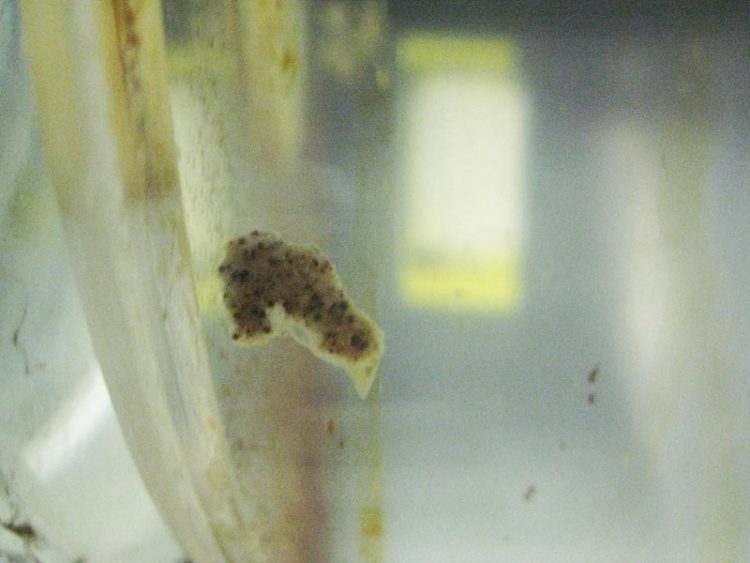Let it snow

This is an example of marine snow formed in roller table experiments designed to investigate conditions that induce its formation. Credit: UCSB
Five years ago, the Deepwater Horizon (DWH) oil rig exploded in the Gulf of Mexico. Since then, scientists have continued to study the effects of the largest environmental disaster in the history of the petroleum industry.
UC Santa Barbara research oceanographer Uta Passow has been investigating the formation of aggregated oil and organic matter, commonly called marine snow. “Marine snow is like dust bunnies in the house,” explained Passow, a research scientist at UCSB's Marine Science Institute who has studied the phenomenon for a long time.
“All the gunk and little pieces in the ocean stick together, and underwater it looks like a snow-storm. The little particles aren't heavy enough to sink, but marine snow is big enough to sink very fast, 100 meters or more per day. It's the only way in which material that grows on the surface, where there is light, goes to depth.
“Before Deepwater Horizon, we didn't even know that oil and marine snow had anything to do with each other,” she added.
Passow's latest research demonstrates that microbes and plankton have distinct interactions with oil, which subsequently provide alternate ways for marine snow to develop. She also found that the presence of the dispersant Corexit used after the explosion likely inhibited the formation of microbial-generated marine snow. Her findings appear online through ScienceDirect and will be published in Deep Sea Research II – Topical Studies in Oceanography in June.
The formation of marine snow, which consists of sinking composite particles greater than 0.5 millimeters, is a common ocean process. In fact, the topography of the northern Gulf of Mexico's continental shelf facilitates a suspended sediment zone. The area is also home to particle inputs from rivers, runoff and coastal erosion. These conditions along with natural hydrocarbon seafloor seeps provide an environment favorable to the formation and sinking of the oiled mineral aggregates that constitute marine snow.
Thanks to the gulf's natural oil seeps, the flora and fauna of the area's marine ecosystem have adapted to small amounts of oil in the water column. However, scientists did not know how they would react to a prolonged release of oil.
After the DWH explosion, oil accumulated at the sea surface and in subsurface plumes. Prior research has documented observations of large marine snow near surface slicks from the spill as well as flaky, oily material coating coral reefs near the spill site.
“The impact of the oil on the open ocean ecosystem when it's disbursed and diluted at the top of the water column is very different from the impacts it has when it sinks and accumulates on the seafloor,” Passow said. “We need to know where the oil is to learn how to keep the damage to a minimum for the whole ecosystem, and for that we need to understand all of the pathways involved.”
To learn more, Passow used roller table experiments to investigate conditions that induce marine snow formation. She also examined the effects of different types of oil (Louisiana light crude, Macondo oil and bucket-collected spill oil), photochemical weathering and the presence of phytoplankton and dispersant on marine snow formation.
She used seawater treatments containing no particles greater than a millimeter. When incubated with collected DWH spill oil, large centimeter-sized marine snow formed. When the seawater was incubated with weathered crude oil, smaller yet similar marine snow formed. “Even when spill oil was added to artificial seawater, marine snow formed,” Passow said. “This suggests that the oil included microbes capable of creating marine snow.”
Passow's research demonstrates the potential of microbial-mediated or plankton-aggregate snow to transport oil carbon to the seafloor. “It is widely believed among scientists that anywhere from 3 to 25 percent of the oil released during the spill was deposited on the seafloor as a result of marine snow sedimentation,” she explained. “However, this pathway was not considered in response strategies, nor was it included in the calculations for the DWH spill.”
She recommended that future modeling efforts and oil spill calculations include marine snow as an oil distribution mechanism and that scientists re-evaluate dispersants as a mediating measure. “This study contributed a central piece toward the understanding of the mechanisms that lead to oil-sinking products,” Passow said.
###
This research was made possible in part by a grant from the Gulf of Mexico Research Initiative to the Ecosystems Impacts of Oil and Gas Inputs to the Gulf consortium. Other funding sources included a Rapid Response Research grant from the National Science Foundation.
Media Contact
All latest news from the category: Life Sciences and Chemistry
Articles and reports from the Life Sciences and chemistry area deal with applied and basic research into modern biology, chemistry and human medicine.
Valuable information can be found on a range of life sciences fields including bacteriology, biochemistry, bionics, bioinformatics, biophysics, biotechnology, genetics, geobotany, human biology, marine biology, microbiology, molecular biology, cellular biology, zoology, bioinorganic chemistry, microchemistry and environmental chemistry.
Newest articles

Silicon Carbide Innovation Alliance to drive industrial-scale semiconductor work
Known for its ability to withstand extreme environments and high voltages, silicon carbide (SiC) is a semiconducting material made up of silicon and carbon atoms arranged into crystals that is…

New SPECT/CT technique shows impressive biomarker identification
…offers increased access for prostate cancer patients. A novel SPECT/CT acquisition method can accurately detect radiopharmaceutical biodistribution in a convenient manner for prostate cancer patients, opening the door for more…

How 3D printers can give robots a soft touch
Soft skin coverings and touch sensors have emerged as a promising feature for robots that are both safer and more intuitive for human interaction, but they are expensive and difficult…





















